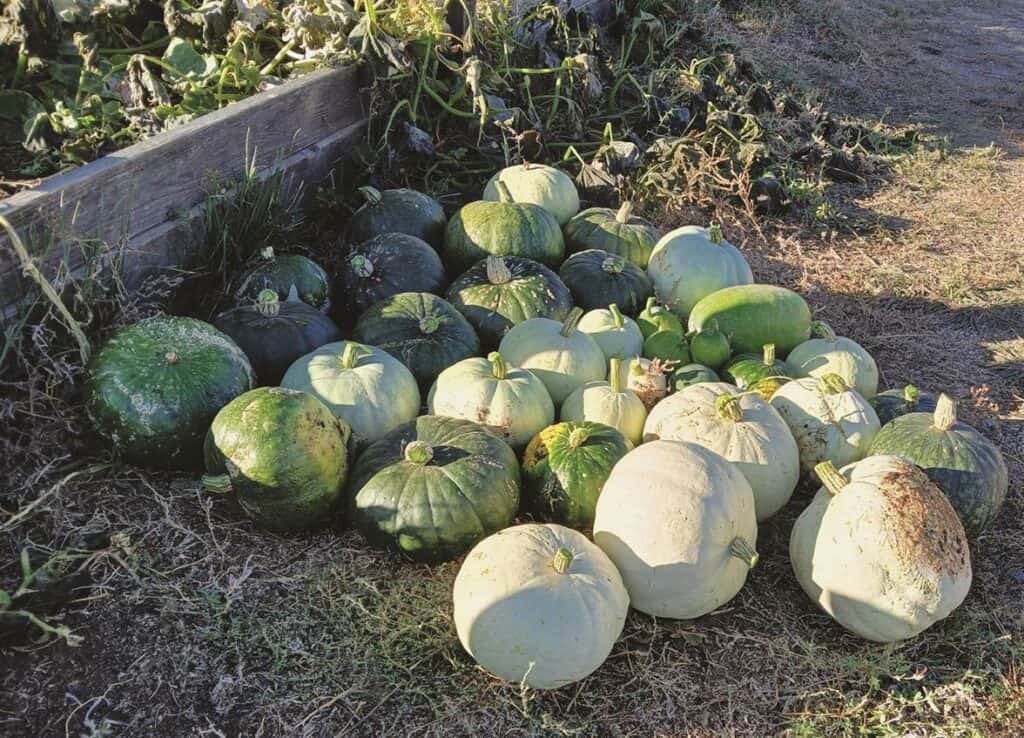Longtime local journalist Bill Radford and his wife, Margaret, live on 5 acres in the Falcon area with chickens, rabbits, dogs, cats, a flock of parakeets, goats and two horses. Contact Bill at billradford3@gmail.com.
Training pumpkins and re-roosting chickens
Today, we’ll be talking about things in trees: specifically pumpkins in trees and chickens in trees.
First, the pumpkins. In the spring, we planted four pumpkin seeds in our front garden bed, along with a few watermelon and ash gourd plants. In a difficult growing season, with the grasshoppers worse than ever, our pumpkin plants prospered.
And climbed. On the northern edge of the garden bed is one of our two front pine trees. Two of the pumpkin plants decided that tree would make a dandy home and sent vines swarming up and all over it. The result: tree pumpkins.
Pumpkin plants apparently are known for their ability to climb — an ability some gardeners harness to grow them vertically on a trellis; thus, preserving additional space on the ground for other plants. While our pumpkins just did their own thing, you can basically “train” your pumpkin to grow upward and onward: thus, the lesson “How to Grow Pumpkins Vertically” at gardenerspath.com.
Besides saving space — and looking cool — the vertically growing pumpkins have another advantage, the website says: By not resting on the ground, “The vines, leaves, and fruits all benefit from better airflow and fewer visits from pests, and therefore less disease and rot.”
Start the training, Gardeners Path says, once your pumpkin has developed young, slightly floppy little vines. Use twine or gardening ties to loosely attach the main vine to the trellis. Then check daily and help guide the vine: “Add twine where you need to and keep it growing vertically.”

Once the pumpkins begin to develop, they’ll need support. The pumpkins in our tree were able, for the most part, to find support by nestling in the branches. With a trellis, you can use a large, netted sling (available, like everything, at Amazon.com) that’s attached to the tree.
Our four pumpkin plants produced a whopping 32 pumpkins. (For the math-challenged among you, that’s eight pumpkins per plant.) A half-dozen of those were tree pumpkins; the rest remained at home on the ground. The other plants? We ended up with a couple of baseball-sized watermelons and one substantial ash gourd (sold as “winter melon” at Asian Pacific Market). Obviously, the pumpkin plants dominated.
And now chickens in trees. I’ve written before about our teen chickens — seven in all. They’ve become part of the main chicken flock but still largely hang out together. And four of them decided that instead of sleeping in the coop with everyone else, they would spend their nights in the branches of our honey locust tree.

I wasn’t a fan of the idea. For one thing, I worried about their safety. The tree (and the chicken pen and coop) are in our side yard, which is fenced. But those chickens sleeping in the coop are protected by two layers of fence.
It seems the tree-sleeping chickens are just following their instincts.
“I think it’s kind of a response to looking for a location to roost that’s maybe a little bit farther from ground predators,” Jesse Lyons, an extension poultry specialist at the University of Missouri, said in a Successful Farming article on agriculture.com. “Many of the flying birds will roost in trees, so I think it’s part of their DNA, their mental survival instincts.”
A tree, however, does not provide protection against predators such as owls and raccoons, the article points out.
Other chicken owners have had similar issues with tree-roosting chickens, judging from comments online. “My chicken is roosting in a tree, not the coop. … Help!” was one lament. The Successful Farming article notes, though, that it can be challenging to get your chickens back on the ground. I’ve tried using a broom to convince them to get out of the tree, but they just climb higher or onto another branch.
Among suggestions by the Successful Farming article: “Use a pole with a hook on the end. Grab the bird’s leg and pull it off the branch. Try enticing your hens to come down at night by only providing food and water in their coop.
“It’s possible to discourage chickens from the tree by placing a fake owl in the branches, but the trickery won’t work for long.”
Some suggest clipping their wings to eliminate what is already a limited ability to fly up into the tree, but that seems cruel to us. The most success I’ve had is in going out in the yard before sunset and chasing the rowdy teen chickens into the pen. (The teens, as in humans, tend to stay up later than their elders.) The other night, though, I went out and found all the chickens, including the teens, either in their pen or their house. So maybe with the honey locust becoming bare and the temperatures falling as winter draws closer, they have figured out that their house is safer and warmer than the tree.
Pull quote: Our four pumpkin plants produced a whopping 32 pumpkins. (For the math-challenged among you, that’s eight pumpkins per plant.) A half-dozen of those were tree pumpkins; the rest remained at home on the ground.





